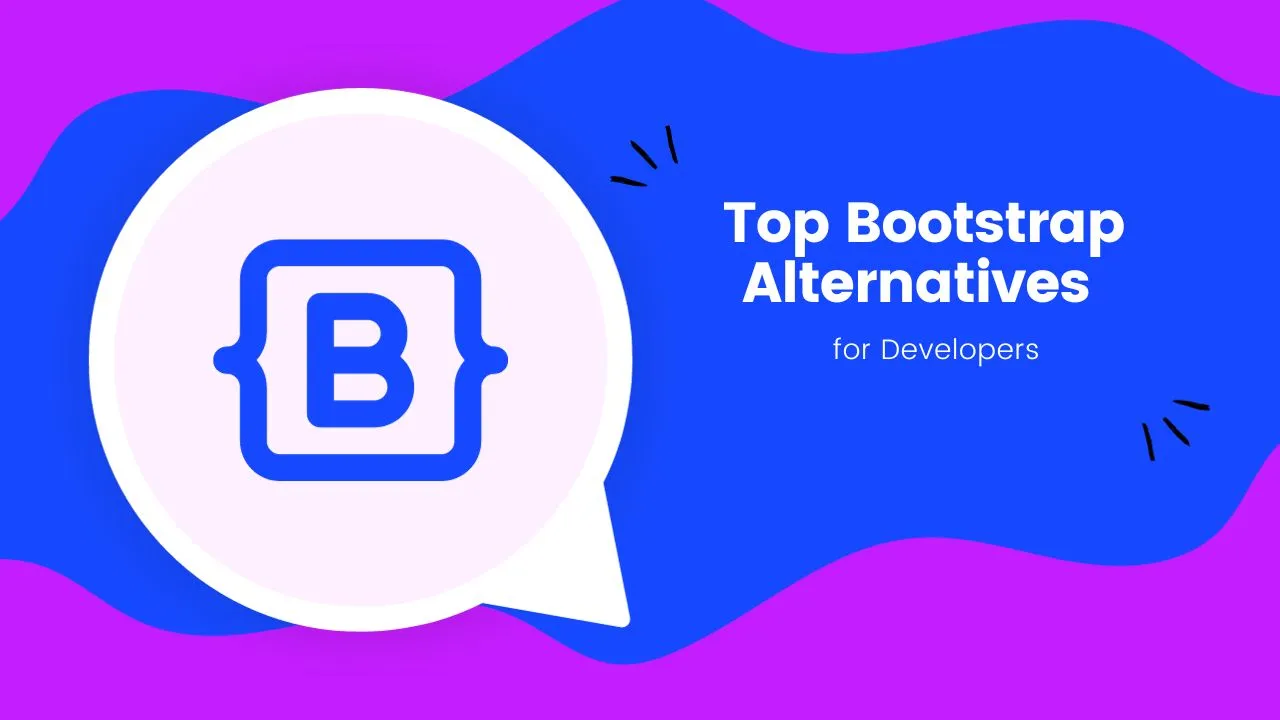Top Bootstrap Alternatives for Developers
Overview
For a very long time, Bootstrap is considered one of the most popular front-end frameworks. It has a huge user base and because of its salient features, it is extremely popular and is among the top choices of developers. But everything in the world has alternatives, therefore, there exist some other frameworks that are equally good and may fit the requirement of the developers just like bootstrap.
Introduction
In today’s world, it is quite important for a website to run correctly and adjust itself on all screen sizes. For such a requirement, we have bootstrap which is a responsive and mobile-friendly framework and is very popular among developers.
However, in spite of bootstrap being amazing at what it does, there are some other front-end frameworks that are alternatives to bootstrap and can be a good fit as per the requirement.
Since the devices like mobiles and tablets have smaller screen sizes and limited memory, therefore, it is quite infeasible to include the complete bootstrap framework in the code because of its large file size. However, you may use other libraries that have smaller sizes but should provide all the necessary functionalities as bootstrap does.
What Is Bootstrap?
Bootstrap is an open-source, mobile-first, responsive front-end framework that helps us in building fast and responsive websites. It simplifies the development of webpages because of its pre-styled components which makes it easy to use. It also uses a variety of utility classes for styling webpages.
Several major components that bootstrap provides are- tables, cards, dropdown menus, buttons, paginations, breadcrumbs, and much more. This huge range of components makes bootstrap a very powerful framework that is extremely popular among developers.
Key Features Of Bootstrap
- It is mobile-friendly with media breakpoints and easy to use.
- It is responsive with browser compatibility.
- It has pre-styled components and a grid system that easily aligns the contents.
- It has built-in jQuery and javascript plug-ins.
- It is flexible and easily integrates with other technologies.
- It has detailed docmentation that makes Bootstrap even more preferable.
- Bootstrap components are easily customizable.
Explore free courses by our top instructorsView All

TARUN LUTHRA
Java Course - Mastering the Fundamentals
79k+ enrolled

RAHUL JANGHU
Python Course for Beginners With Certification: Mastering the Essentials
69k+ enrolled

PRATEEK NARANG
C++ Course: Learn the Essentials
41k+ enrolled
35,262+ learners have attended these Courses.
Top Bootstrap Alternatives
There are many alternatives that can be used by the developers that are equally good or even better than bootstrap. Here is a list of bootstrap alternatives that have been curated with great research and analysis.
Skeleton
Skeleton is a simple and lightweight CSS framework. It is majorly popular because of its 12-column fluid grid system that consists of rows and columns. It is responsive in nature and adopts a mobile-first approach. Therefore, whatever the size of the screen may be, the layout serves as a major attraction while using the skeleton framework.
It is considered a suitable alternative to bootstrap if the user wants to build something small as they will not be requiring heaps of utilities of a much larger framework. It offers basic components like buttons, forms, tables, lists, and much more. Its syntax is easy to implement, therefore provides responsive styling in a simpler manner.
Bulma
Bulma is one of the popular CSS frameworks that can be used as an alternative to Bootstrap. Bulma is free, open-source, and has a ton of front-end components that are enough to code any kind of website. It is actually the first CSS framework that has implemented a full-fledged flexbox. Moreover, it is 100% responsive and built keeping in mind the mobile-first approach.
Bulma comes with a wide variety of colors that make it a beautiful framework for creating good-looking websites with ease. However, one of the disadvantages of Bulma is that it is only a CSS framework with no javascript. Therefore, the user has to write its own javascript or jquery to toggle dropdown menus and other such actions.
Pure.css
Pure.css is a CSS framework made up of CSS modules that are clustered together. It is extremely lightweight as it is built keeping mobile devices in mind. It is appropriate for small projects, especially for mobile devices.
It is used to make responsive websites with the help of components like buttons, menus, grids, forms, etc. However, it is tiny in size, yet it provides great performance and output.
Groundwork
Groundwork is a responsive, HTML, CSS, and Javascript framework that is used to make scalable web applications. It is quite efficient because of its fluid grid layout system which is easily configurable and adaptive. It also has complete support for ARIA attribute selectors.
It is easily available and can work with all kinds of devices. It is built on top of SASS and offers all the tools required to create tablets, text headings, blocks, etc. Also, this framework is customizable, that is, you can put in your own styles for adding additional functionality to your websites.
Cardinal
Cardinal is a mobile-first, CSS framework that is used to build responsive and scalable applications. It offers high performance, scalability, and maintainability. Moreover, it also provides the flexibility to design and be creative to the developers.
It has several helper classes that are used better and quick application of styles which in turn reduces the development time. It is compatible with most browsers. Moreover, with its mobile-first approach and CSS box model, it is a perfect alternative to Bootstrap.
PowertoCSS
PowertoCSS is a simple, light-weighted frontend framework. It is based on Scalable and Modular Architecture and DRY (Don’t Repeat Your CSS). It is easy to learn with easy class names. It offers versatile functionalities.
It is small in size and quite fast in performance and loading. You can even create personalized designs using this framework. It is flexible and easily customizable as per the user's needs.
Mueller
Mueller framework is a frontend responsive framework and is based on SASS and Compass frameworks. It creates a grid using the grid function (grid()) that helps in the addition of classes directly to the elements to keep the HTML elements neat. It has one default grid and other pre-media grids, however, the media grids can be extended to pre-defined layouts.
Mueller gives complete access to column width, baseline grid, and media queries for customizing the components of a website. It is very suitable for adaptive and responsive layouts.
Bootflat
Bootflat is a UI KIT framework that is used to create beautiful and stunning web designs. It works on top of Bootstrap, therefore, follows a flat design. It is very much compatible with modern-day browsers.
The components of Bootflat are made using HTML5 and CSS3. It also has an in-built color scheme for easy customization. It also follows a mobile-first approach and provides plugins that give a great performance boost.
Materialize
It is a modern responsive framework that is based on Material Design by Google. As materialize is based on the principles of Material Design, therefore, it incorporates many components and animations of Material Design which gives effective feedback to users. It fastens the development time because of its default styling and customized components.
Moreover, it also provides detailed documentation with suitable code examples to help beginners understand it well and faster. It offers components like SASS mixins, card designs, a drag-out mobile menu, ripple effect animation, etc.
Tailwind CSS
Tailwind CSS is a frontend framework that mainly focuses on utility classes just like bootstrap does. It has a number of utility classes that can be used to make any layout very easily. It is a highly customizable and low-level framework.
It is component friendly as you can easily create any component of your own. However, it is lesser stuff in the CSS bundles but all its utility classes are responsive in nature.
HTML5 Boilerplate
HTML5 Boilerplate is not a framework but a frontend template that has HTML, CSS, and Javascript. It can be used to build any kind of webpage or layout as it has been designed keeping in mind an advanced thought process. A webpage designed using HTML5 Boilerplate is robust in nature.
It has extremely simple documentation which is easy to understand by the developers. It is also used to create websites with cross-browser compatibility. However, it is not a framework but being a template, it has its own merits like having an built-in support of webpage printing, therefore, it can replace bootstrap for creating fast, robust and easy UI designs.
Metro UI
Metro UI is a frontend framework that is quick and efficient and brings the concept of Metro Design Language from Windows. With this framework, you can design a number of layouts since it has over 100 user interface components and over 500 built-in icons.
It is free, open-source, and offers internationalization support. It also comes with a Javascript library M4Q which is a substitute for JQuery and based on which many Javascript functionalities are created. It is quite easy to use since the user doesn’t need to know javascript in detail.
UIKit
It is a lightweight, easy-to-use front-end framework. It is modular and responsive and has many components that are wired either with HTML markup or Javascript code. It contains a set of files with components like fonts, icons, documentation, etc.
It creates pixel-perfect layouts and fast web interfaces. It also provides an inbuilt icon library and offers interoperable CSS pre-processing with SASS or Less.
Element
It is a component-based UI library for developers, designers, and product managers. It is mainly meant for Vue.js applications since it contains pre-designed and reusable Vue.js components.
In this library, each UI entity is an Element-Based project, even the building blocks like grids and layouts. It has flexible themes and internationalization support. It is popular because of its salient features which are effectiveness, feedback, reliability, and controllability.
Onsen UI
It is a front-end framework for mobile, web, and hybrid apps. It also allows the developers to create mobile applications using the web technologies like HTML, CSS, and Javascript. It contains all the UI components that are needed to create a mobile UX.
It gives its users a native feel with a lot of ready-to-use components and customizable themes. It has strong connections with other frameworks like Angular, ReactJs, Vue.Js, Angular.JS, etc. It is considered one of the most efficient frameworks to create mobile, web, and hybrid applications.
Cirrus
It is a completely responsive, component and utility-based SCSS framework. It can easily be integrated with any existing design or can be used for a completely new project as well. It is responsive to effective controls and has a simple structure.
It has two alternatives for layout design- a flexbox, and a grid. It comes with two packages - the “core” package and the “ext” package. The “core” package comes with simple styles and functionalities whereas the “ext” package extends the “core” package with a subset of its components.
MontageJS
MontageJS is an open-source frontend framework used for developing single-page applications. It focuses on the maintainability and performance of the application by providing modular components, and data bindings.
It also provides a full software development kit known as Montage Studio for the creation and maintenance of single-page web applications. It also makes it easier to manage the web applications and UI state with data bindings. Moreover, it provides a reusable environment that makes it easier for the developers to test the code and try it again.
Pure CSS
It is a very tiny frontend framework with the least number of styles. It is used to develop faster websites with a responsive layout. It uses Normalise.css for providing styles and other UI components. It uses SMACSS to modularize the CSS code in which each module is kept in separate files that are very small in size making it more efficient.
However, since it is responsive, therefore, fits all device screen sizes. It provides components like navigation menus, grids, tables, buttons, etc for creating effective styles on top of which the developers develop their own projects.
Semantic UI
It is a very popular framework among developers because it allows writing human readable HTML code instead of verbose methods. It has a large collection of components that can be used anywhere in HTML and you will get instant results for the same.
It is responsive in nature and is used to create attractive web layouts. Moreover, it can work with various devices. It includes functionalities like debugging using Javascript plugins making it even more attractive.
Flexbox Grid
Flexbox Grid is a type of grid system that is based on flex display property. It is very similar to Bootstrap's 4-grid system. It is very easy to learn and has a simple syntax. You just need to remember the row, column, and content to design a layout using the flexbox grid.
It works better in a single dimension either the row or the column and has a space distribution between the components for arranging them in that single row or column. Moreover, it makes the webpage responsive and fluid.
Foundation
It is an advanced, open-source, responsive frontend framework. This framework is used to create beautiful websites, emails, and applications that can work with all types of devices.
It includes all the components such as buttons, grids, typography, etc that are needed to design any web layout. It handles HTML emails using the Foundation by Emails feature. Moreover, this framework has continuously updated and come up with its latest features.
Inuit CSS
Inuit CSS is SASS based frontend framework. It does not give you UI components or designs but it provides you with an architectural foundation upon which you can create your own unique project. It is extensible and scalable. It is free from styling and can be used with any type of project.
It is considered to be a mix of OOCSS and BEM frameworks. It is more suitable for large projects. It is also a mobile-first framework and is created to be used on tiny-sized screens with the least effort.
Jeet
It is a grid framework, basically for SASS projects. These grids are written using semantic markup depending on the heavy utilization of mixins. Using the Jeet framework, we can create faster web applications with lesser code and more flexibility.
It is an alternative that has a focus on style, markup, and semantics. Since it is lightweight and has a responsive grid system, therefore, it is easy to understand. However, it has outdated techniques for layouts.
INK
It is a very popular web designing framework that was created by the Portuguese company SAPO. However, they introduced the INK framework to speed up their own websites but with time it became flexible enough to be used with any web application.
It includes inbuilt features such as typography, javascript plugins, etc. These features help developers to customize the elements while using them in any web application. It has a responsive grid system, common interface elements, fast development, and user-friendliness, owing to which it is quite popular among developers.
Kickstart
It is basically a CSS library that was stripped of some components that would turn it into a completely functional frontend framework. It is actually a kickstart boilerplate library. It is lighter than Bootstrap.
It consists of HTML, CSS, and JQuery files that would be needed by the developers to kickstart a new project. It is already been used in production websites for a very long time. It contains elements like form styles, buttons, slideshows, typography, etc for creating the user interface of the websites.
Conclusion
- Bootstrap in itself is a great and very popular framework but it also has several alternatives that can be used in place of bootstrap for creating attractive web applications.
- It depends on the need of the project by which you can choose a particular framework.
- Each of the layouts discussed has its own merits through which it can be chosen for creating effective designs.
- The Skeleton framework's major attraction is it's layout as it has 12-column fluid grid system and is useful if we are dealing with small projects whereas Bulma have extremely beautiful color varieties which can be used to make different UI designs.
- Groundwork is built on top of SASS and provides all the tools of SASS and additional components whereas Metro UI brings in the concept of Material Design Language from Windows.
This blog post was originally published at: Source
